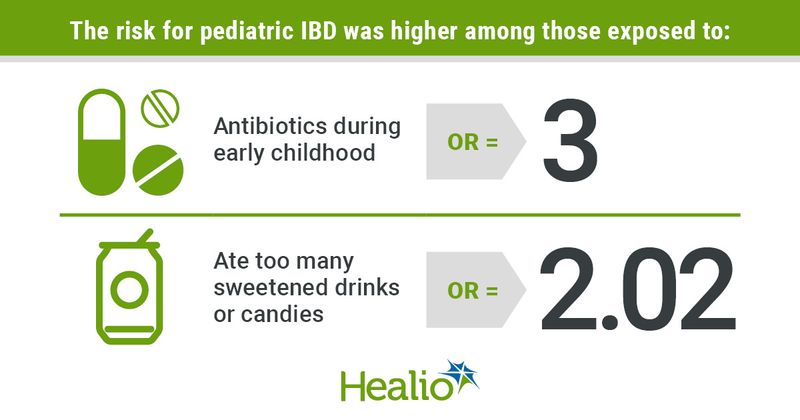Frequent antibiotic use, diet rich in sweets, urban living heighten risk for pediatric IBD
CHICAGO — A diet rich in sweetened candy or drinks, exposure to antibiotics during early childhood and urban living were among risk factors for developing pediatric inflammatory bowel disease, according to data at Digestive Disease Week.
“Recognizing the impact of pediatric‐specific modifiable and nonmodifiable causative factors, and considering these during a clinical work-up, may help in identifying children at higher IBD risk who could be monitored closely with lower threshold of suspicion for IBD development,” Nisha Thacker, a practicing dietitian and PhD candidate at the University of Newcastle School of Health Sciences and Children's Hospital Westmead in Australia, told Healio.

To understand the influence diet and environmental factors have on pediatric IBD, Thacker and colleagues performed a systematic search to identify studies linking diet and environmental exposures before diagnosis of pediatric IBD. Of 4,763 studies screened, researchers analyzed 36 observational studies, which included 6,463,448 participants.
According to results, the odds of a pediatric IBD diagnosis were markedly higher among individuals who were exposed to antibiotics during early childhood (OR = 3; 95% CI, 1.9-5.16) or who had more than four courses of antibiotics in childhood (OR = 3.63; 95% CI, 2.59-5.08).
Additionally, atopic conditions significantly increased the odds for pediatric IBD (OR = 1.65; 95% CI, 1.28-2.13) as did high socioeconomic status (OR = 3.43; 95% CI, 2.11-5.55), passive smoking (OR = 2.34; 95% CI, 1.51-3.64), urban living (OR = 1.7; 95% CI, 0.96-3) and a history of not having been breastfed (OR = 2.49; 95% CI, 1.13-5.46). Eating too many sweetened drinks or candies also increased the risk for pediatric IBD (OR = 2.02; 95% CI, 1.06-3.85).
Conversely, having more than two siblings (OR = 0.69; 95% CI, 0.64-0.74) and being exposed to pets or cattle (OR = 0.53; 95% CI, 0.39-0.73) significantly reduced the risk for pediatric IBD, researchers reported.
“Clinicians could encourage healthy early-feeding practices, including breastfeeding, and guide families on other known risk and protective factors, especially for those families presenting with nonmodifiable factors like having a IBD family history,” Thacker said.
“Referring high-risk families to a dietitian to help adopt a healthy, whole food-based diet can be beneficial. This may help minimize the compounding effects of Western diet pattern on the genetic risk.”

